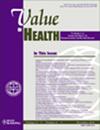实施镰状细胞病(SCD)的广义风险调整成本效益(GRACE)模型-一个案例研究
IF 6
2区 医学
Q1 ECONOMICS
引用次数: 0
摘要
目的:本研究旨在通过实施广义风险调整成本-效果(GRACE)方法来量化治疗镰状细胞病(SCD)的社会价值,从而在成本-效果分析(CEA)中调整疾病严重程度、减少治疗结果的不确定性以及生活质量(QoL)和预期寿命(LE)之间的权衡等因素。方法:使用GRACE,我们重新校准了SCD中最近的健康技术评估(HTA),用于两种基因疗法,lovo-cel和exa-cel。GRACE框架通过根据未治疗的疾病严重程度调整支付意愿(WTP)阈值,纳入治疗结果的不确定性,以及改变不同健康状态下LE和QoL之间的替代率,修改了现有的CEA。结果:GRACE框架的实施导致lovo-cel和exa-cel的直接和社会增量成本效益比(ICERs)降低6%,表明每个质量调整生命年分别从192,651美元和161,816美元减少到182,036美元和152,900美元。此外,WTP阈值增加了约50%,反映了GRACE治疗的更高评价。grace调整后的估计表明,从直接付款人和社会角度来看,lovo-cel和exa-cel具有成本效益。结论:GRACE方法能更全面、更准确地估算社会价值,实现更高效、更公平的资源配置。本研究不仅突出了传统CEA在获取重症治疗的总社会价值方面的局限性,而且为将GRACE模型元素纳入hta提供了路线图,从而促进了创新疗法的广泛接受,从而显著提高患者的生活质量。本文章由计算机程序翻译,如有差异,请以英文原文为准。
Implementing the Generalized Risk-Adjusted Cost-Effectiveness Model for Sickle Cell Disease: A Case Study
Objectives
This study aims to quantify the societal value of curing sickle cell disease by implementing the generalized risk-adjusted cost-effectiveness (GRACE) method, thereby adjusting for factors such as disease severity, reduction of uncertainty in treatment outcomes, and trade-offs between quality of life (QoL) and life expectancy in a cost-effectiveness analysis (CEA).
Methods
Using GRACE, we recalibrated a recent health technology assessment in sickle cell disease for 2 gene therapies, lovo-cel and exa-cel. The GRACE framework modified existing CEA by adjusting willingness-to-pay thresholds based on untreated illness severity, incorporating treatment outcome uncertainty, and varying the substitution rates between life expectancy and QoL across health states.
Results
Implementing the GRACE framework resulted in a 6% reduction in both direct and societal incremental cost-effectiveness ratios for lovo-cel and exa-cel, demonstrating a decrease from $192 651 and $161 816 to $182 036 and $152 900 per quality-adjusted life year, respectively. Additionally, willingness-to-pay thresholds increased by approximately 50%, reflecting a higher valuation of treatments under GRACE. GRACE-adjusted estimates suggest that lovo-cel and exa-cel are cost-effective from both direct payer and societal perspectives.
Conclusions
The GRACE method offers a more comprehensive and precise estimation of societal value, leading to more efficient and equitable resource allocation. This study not only highlights the limitations of traditional CEA in capturing the total societal value of treatments for severe diseases but also provides a roadmap for incorporating GRACE model elements into health technology assessments, thereby facilitating a broader acceptance of innovative therapies that significantly enhance patient QoL.
求助全文
通过发布文献求助,成功后即可免费获取论文全文。
去求助
来源期刊

Value in Health
医学-卫生保健
CiteScore
6.90
自引率
6.70%
发文量
3064
审稿时长
3-8 weeks
期刊介绍:
Value in Health contains original research articles for pharmacoeconomics, health economics, and outcomes research (clinical, economic, and patient-reported outcomes/preference-based research), as well as conceptual and health policy articles that provide valuable information for health care decision-makers as well as the research community. As the official journal of ISPOR, Value in Health provides a forum for researchers, as well as health care decision-makers to translate outcomes research into health care decisions.
 求助内容:
求助内容: 应助结果提醒方式:
应助结果提醒方式:


